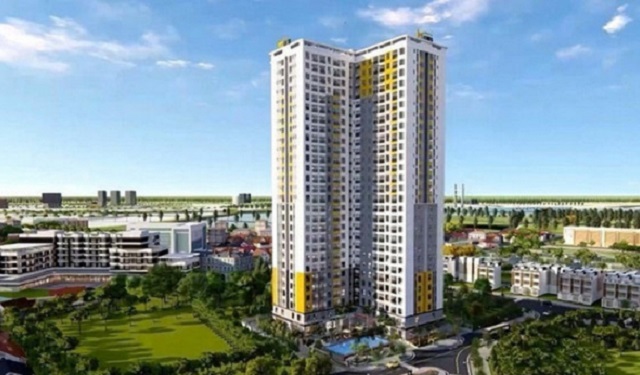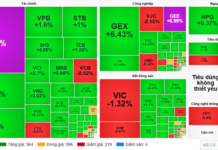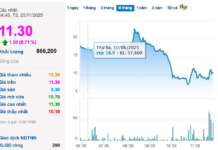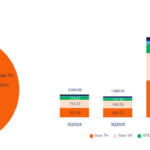
Vung Tau Ward Real Estate. (Photo: Huynh Son/TTXVN)
|
Lowering housing prices has become an urgent necessity as property values continue to soar, far exceeding the affordability of the majority of the population.
However, this challenge is far from simple, given the significant gap between “on-paper” costs and actual expenses. Adding to the complexity, local authorities are preparing to release the 2026 land price list, which is expected to show a substantial increase.
The risk of a new price surge makes the goal of reducing housing costs even more elusive. Experts unanimously agree that to lower housing prices, intervention at the root cause is the key.
Pressure from Rising Land Costs and Intangible Expenses
Many real estate companies report that land costs are the heaviest component in their input structure. If the new land price list continues to rise, land use fees and compensation costs for site clearance could increase total investment by hundreds to thousands of billions of dong. In such a scenario, reducing housing prices becomes extremely difficult.
It’s not just businesses that are affected; even individuals seeking to change land use purposes face concerns about significantly higher financial obligations. If lower prices are proposed, those whose land is being acquired worry about inadequate and unfair compensation. These conflicting interests make land costs increasingly difficult to control.
According to the Vietnamese Valuation Standards (Circular 42/2024/TT-BTC), total project development costs include construction, contingency, business, financial, tax, and investor profit expenses. Compensation and site clearance costs are separated to accurately reflect input values.
However, actual survey data in many localities remains outdated, leading to cost calculations based on old standards that do not align with current material and labor prices.

Apartment projects in Thu Duc City, Ho Chi Minh City. (Photo: Hong Dat/TTXVN)
|
Bui Van Doanh, Director of the Vietnam Real Estate Research Institute (VIRES), notes that while standards are clear and transparent, their practical implementation lags behind. This gap makes effective control of housing prices challenging.
From a business perspective, Nguyen Chi Thanh, CEO of Ho Tay International Building Company, explains that housing project investment costs span dozens of categories, with land and legal issues being the most significant bottlenecks. For apartments, land costs typically account for 30-40% of total capital; the “cleaner” the land, the higher the price.
Construction accounts for 35-40%, covering everything from foundations and structures to electrical systems and landscaping. Notably, many “soft” costs, such as design, legal fees, marketing, and brokerage commissions, make up 15-20% of the total cost but are rarely discussed.
Additionally, financial costs are a significant burden. For projects with capital in the thousands of billions of dong, companies are forced to borrow from banks at interest rates of 12-14% per year. However, if procedures are delayed by just one year, capital costs can increase by hundreds of billions of dong, as Mr. Thanh points out.
Therefore, to reduce housing prices, experts emphasize the need to first make all cost components transparent, especially land and administrative procedures. When input costs are clear, regulatory bodies can adjust taxes, land price coefficients, or credit policies, rather than relying on rigid administrative measures.
Regulation at the Source
Bui Van Doanh believes that direct state intervention in selling prices is “very difficult and almost unfeasible.” Instead, the state should regulate input costs and apply tiered tax policies to allow businesses to set prices autonomously.
A profit tax model based on market segments could be considered. For example, high-end commercial housing could be taxed at a higher rate since it serves higher-income groups. In contrast, reasonably priced commercial housing and social housing could be taxed at lower rates to reduce input costs and lower selling prices.
This model promotes fairness and compels businesses to optimize costs if they want to compete in the most in-demand market segment—affordable housing, as Mr. Doanh suggests.
Furthermore, shortening project approval times, ensuring transparent material price data, and establishing preferential credit mechanisms for social housing are essential. When businesses reduce land, financial, and procedural costs, housing prices will naturally decrease without administrative mandates.
“The root problem lies in planning and land pricing. Developing projects that even local residents cannot afford is ineffective planning,” Nguyen Chi Thanh points out.
Localities should invest in large-scale urban areas with complete infrastructure on new development land to make land costs more reasonable. Currently, a common “mistake” is using the high selling prices of previous projects, often created by major brands, as the basis for calculating land use fees for subsequent projects, driving land prices to unrealistic levels.
To reduce costs, Mr. Thanh also proposes applying standardized design modules for large-scale projects, which can lower design costs and shorten implementation times. When design costs decrease, businesses can reduce selling prices while maintaining quality.
Recently, the draft Resolution on mechanisms to control and stabilize real estate prices has been open for public comment. It focuses on tightening speculative credit and reviewing land use fees.
However, experts view this as only a temporary “fever-reducing measure.” For housing prices to decrease sustainably, policies must address the root causes by regulating land value increases and reforming the land tax system.

Apartment building by BCONS Group in Binh Thang Ward, Di An City. (Photo: Duong Chi Tuong/TTXVN)
|
Dr. Thai Quynh Nhu, former Director of the Land Management Research Institute, notes that every time public investment is made, roads are built, or planning is adjusted, land prices surge immediately, but the state fails to capture this increased value. When land prices are “driven up” by factors unrelated to business investment, input costs for adjacent projects rise, causing housing prices to escalate uncontrollably.
Therefore, Dr. Nhu proposes separating two types of land rent. The first is differential rent created by the state and community (planning, infrastructure, etc.), and the second is differential rent resulting from business investment. The state should recover a certain percentage of the differential rent created by the state and community.
For example, in transportation infrastructure projects, the state could collect 40% of the added value; in real estate projects, a 50-50 split between the state and the developer could be applied. For industrial projects, the state might collect around 30% to encourage production investment.
This mechanism helps prevent revenue loss, curb land speculation near planned areas, and reduce land costs—the largest component of housing prices. Additionally, a comprehensive land tax system should be developed to avoid “tax layering,” as experts advise. Currently, real estate transactions are subject to numerous financial obligations. If new taxes are imposed without proper tiering, housing prices could increase further.
Many experts agree that reducing housing prices is not an overnight task. Prices can only decrease when the entire ecosystem—from planning and administrative procedures to land valuation, taxation, and credit—operates transparently and consistently.
This means businesses can reduce land, capital, and time costs. The state can reasonably regulate land value increases. Speculators will lose the incentive to “hold land for future gains.” Middle- and low-income earners will gain access to affordable housing.
If these solutions are implemented comprehensively, the dream of stable housing for millions could become more attainable, not through administrative mandates but through a transparent and fair market mechanism./.
Thu Hang
– 17:20 26/11/2025
Thailand’s Renewable Energy Giant Rakes in Over $90 Million in Vietnam in Just 9 Months
Super Energy, a leading Thai renewable energy company, has made significant strides in Vietnam with its impressive portfolio of projects. Among its notable ventures are the Lộc Ninh 1, 2, and 3 solar power plants and the HBRE Chư Prông wind farm. The company recently released its third-quarter business report for this year, showcasing its continued growth and impact in the region’s renewable energy sector.
Dr. Trần Quý: In the Era of Aspiration, Policies Are Not Barriers but Value Filters
Speaking at the SIHUB seminar on the afternoon of November 26th, Dr. Tran Quy asserted that Vietnam is entering a new phase of governance, where policy becomes the pioneering force and filtering mechanisms are in place to attract valuable capital, technology, and talent, rather than lagging behind reality or creating barriers.













































